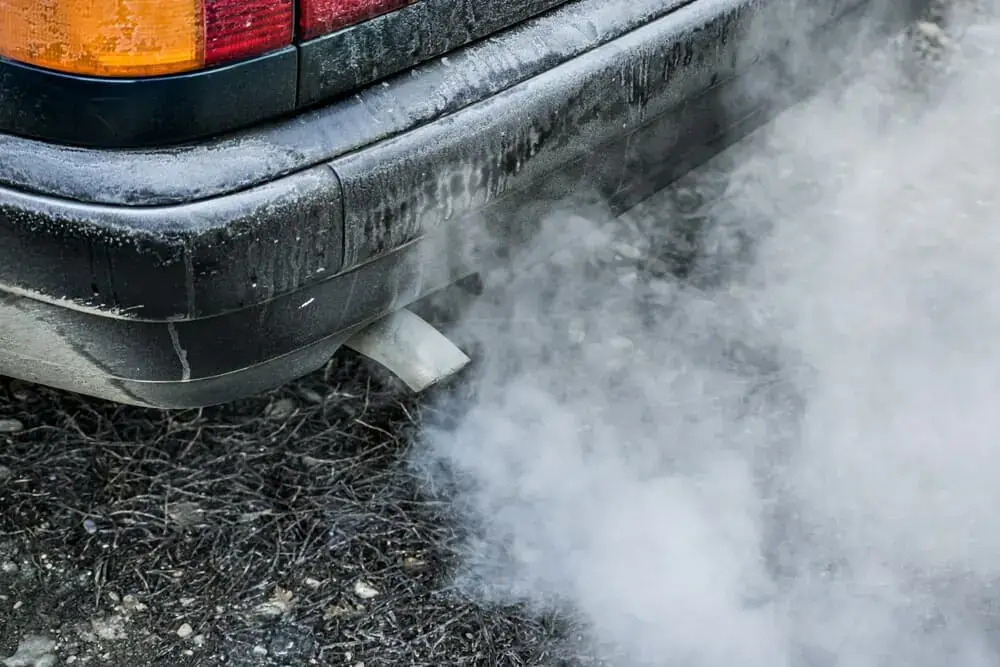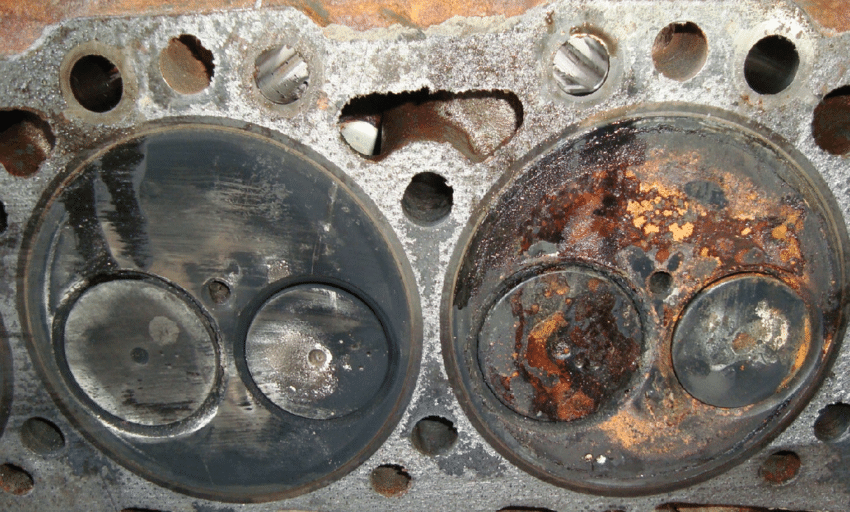Sometimes it’s harmless when you see your exhaust smoking. But if it happens only when the AC is on, you need to pay attention. But it’s better to know what caused it than to ponder.
That brings us to the query, why white smoke from the exhaust when AC is on?
If the car is overheated there can be white smoke coming out from the exhaust. This overheating can be caused by having an insufficient level of coolant. If you have an abnormal depletion of coolant then check for leakage. You can either fix the leakage by yourself or take it to the mechanic.
Before going to your mechanic let’s go through this and know what actually happened!
You’ll probably be able to fix it all by yourself so stay with us!
Why is White Smoke Coming Out of My Car’s Exhaust?
Well, as a car owner it’s worrisome if you see a smoking exhaust. But it’s very common if you see this on a winter morning.
If you live in a warm area like California, then it’s not normal.
If you are noticing a small amount of smoke from your exhaust because of the cold, your engine might be heating up.

But if there is thick and white smoke from the exhaust, you should take action immediately.
Sometimes your car will produce white smoke and jerk when the AC is on. Only then does the problem directly affect the coolant of your car’s AC.
No worries, we won’t make you wonder anymore. Let’s know what caused this!
White Smoke Coming Out When AC is on: Things You Can Do!
The first thing I would like to share with you is that ‘Coolant Leaking’ can cause serious smoking from the exhaust.
Every car owner knows the struggle of having a damaged reservoir tank. This tank will not be able to contain the coolant perfectly.
It’s hard to prevent the coolant from leaking if there is a crack.
You also should check your engine’s combustion chambers. Sometimes coolant leaking can lead to them.
Many mechanics will assume the worst. And it might lead you to spend more than you want.
Well, let’s end all of your concerns with these four easy steps!
Step 1 of 4: Checking the Coolant Level
The first thing you should do is check the coolant tank. In order to do that follow the following steps-
- First of all, park your car on a flat surface. Now, open the hood of your car. You will notice a reservoir cap. Don’t touch it if the engine is still hot.
- After the engine cooled down, look into the coolant chamber. You will notice some terms like “Low” and “Max” on the side of the chamber.
- If the coolant is almost at the low that’s a problem. You can also use a stick to check how much is left down there.
If you’re confused about how to measure the coolant level then you can check out this video here.
Less coolant in the reservoir tank means your car can’t perform cooling. And the coolant can also get mixed with engine oil.
If the coolant level isn’t at the expected level then there is a possibility of leakage.
So now, we will try to find out the coolant leakage!
Step 2 of 4: Detecting the Leakage
To detect the leakage, we need to put pressure up to a specific range on the radiator cap. If the system is not able to hold, there must be a leakage.
If the system can take pressure for more than two minutes, you’re in luck!
So, the leakage must be happening externally. You need to look for any cracks in the head gasket.
The easy way to understand this is, by asking yourself one question. And that is, does your engine overheat when the AC is on?
If the answer is yes, your intake manifold gasket is damaged. Now, you need to see if there is any kind of crack in the head gasket.

The Head gasket protects the cylinder from the coolant.
Another place you need to look for is a crack in the cylinder head. This head is made out of aluminum. And it can start creating a crack in case of overheating.
Detecting the leakage is not complicated but it can take time. So be patient and find the leakage.
After you have successfully detected the leakage. It’s time to fix it!
Step 3 of 4: Fixing the Leakage Yourself
Fixing a coolant leak can be tough, but it can also be done easily. Yeah! It’s funny but trust me when I tell you this, even eggs can fix it!
Don’t believe me? Well, just crack a few eggs in the radiator reservoir. As the eggs start cooking, they will get clogged in the leak holes.
But we don’t suggest this method as this is temporary. It should be the last method if you are trying!
So let’s get down to the main part!
Replacing the Reservoir Cap
If the reservoir cap or the clamps have leakage you need to replace them.
- Just detach the old clamp and the affected hose.
- Throw out the coolant which is already inside.
- Now, put on a new radiator cap you can use the Stant 10230 Radiator Cap or get yourself the ever-reliant ACDelco 15 P.S.I. Radiator Cap.
- Don’t forget to fill up the reservoir tank with fresh coolant. For coolant, Valvoline Multi-Vehicle 50/50 Prediluted Ready-to-Use Antifreeze/Coolant is always my choice.
Replacing the Radiator
Now, check if the radiator seems to be having the problem. You can easily swap out the radiator.
- Just turn off the radiator. And disconnect all the pipes and hoses. Check if your radiator has a fan. If there is, remove that too.
- All you need to do is drain all the coolant and take out the radiator.
- Now just put everything back to reverse, but with the new radiator.
If you still can’t seem to stop smoke coming out of the exhaust, it’s time for a professional to check it.
Step 4 of 4: Seeking Professional Help
Let’s be real! We are no car mechanics to understand and fix the car fully. We have tried our best, but it’s time for a mechanic to look at your car. Also, this is the best solution to this problem to be very honest.
Make sure you describe the whole situation to your mechanic. If needed demonstrate the problem with your car.

Let me give you an idea of what you might be looking to spend.
Repairing a coolant leakage can cost you from $20 to $3,200. Yes, you read it correctly. The price range is huge.
Because if you need a new hose or a new claim it will cost you around $100. But if a radiator is cracked, it sometimes cannot be fixed.
There is a chance that you need to change the whole radiator unit. To do that, you will be spending from $280 to $1,500.
The fact about the price is, the lesser the problem the lesser the costing. So, if you want to save up, get to the mechanic soon.
Car Maintenance: Preventing It From White Smoke!
Owning a vehicle comes with a few responsibilities. Obviously, you don’t want to face these situations again, right?
So, just start maintaining your car’s internal air conditioning system.
Keep in mind that you need to keep the coolant reservoir tank filled all the time. The coolant should be watered-down.
Whenever you fill-up the coolant, tightly put the cap on. Clean up the radiator a few times each year.
If the engine is overheating do not wait to go to a technician. It’s better not to think about saving when it’s time for annual car servicing.
Tire, engine oil, coolant, radiator fluid, you need to get everything from a trusted store.
Keep in mind one thing, any kind of fluid on the engine can cause smoking. So even if your transmission cooler line breaks down, you will see smoke.
Finally, for safety reasons you should not drive your car when it’s showing problems.
Well, that’s all you needed today!
Frequently Asked Questions (FAQs)
Does white smoke mean my head gasket is blown?
White smoke from your exhaust means it’s the coolant leaking. And most likely the coolant is getting into the cylinder. But the head gasket is between the cylinder head and main engine block. So, your head gasket is not blown.
Why is my car smoking but not overheating?
Most likely you got a type of fluid landed on your engine. This fluid can be motor oil, coolant, or transmission fluid. If you live in a colder area it can also be condensation. If there is fluid on your engine, it will burn off. As a result, you will see smoke coming out of your car.
Can I drive my car while it’s smoking white from the exhaust?
The simple answer to this is, yes you can but you should not. As soon as you notice the smoke you should stop driving. You can be overheating and it can damage your engine. If you choose to ignore the smoke, not only will it damage the car, it is also a risk for you.
Conclusion
Well, now you know all about why white smoke from the exhaust when AC is on. You have the knowledge to fix this yourself!
But if you are not able to do it, a professional mechanic surely can.
Have a good drive and leave us with any comments!
- Is The Jeep Cherokee Frame or Unibody (Briefly Answered) - November 10, 2022
- Are Titan Wheel Spacers Good (The 360 Guidelines) - November 9, 2022
- FCW off Jeep (Is It Important for Your Car) - November 9, 2022

Howdy Robert,
Another great post!
Well, I’d never met this problem before, so I didn’t have any idea when this problem happened.
3 days ago, when I turned the AC on, white smoke appeared, continuously.
After reading this post, I checked my car carefully and found my issue (a blown head gasket). I gonna replace it on my own today.
Thanks for your great work.